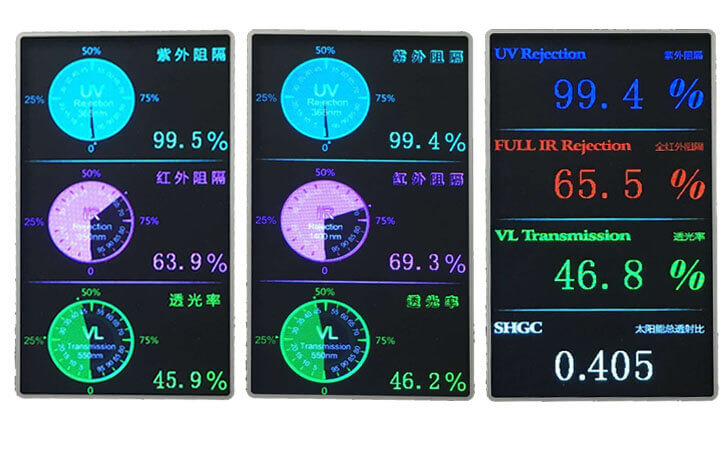How to know the thermal performance of the window tint?
The window film transmission meter can emit light through the built-in light source, then receive the light from the receiver on the other side.And finally the instrument can calculate the transmittance of the measured material by dividing the luminous flux of the measured material by the original luminous flux.The rejection rate is calculated by subtracting the transmittance from 100%.
The window film transmission meter mainly reflects the light transmission performance of the solar film by the light transmittance,reflects the heat insulation performance by the infrared rejection rate and reflects the ultraviolet shielding performance by the ultraviolet rejection rate.Many customers may ask,can this instrument measure the heat insulation rate?
We usually understand the infrared rejection rate directly as the heat insulation rate. The higher the infrared rejection rate,the higher the heat insulation rate.But in fact, the true heat insulation rate refers to the material's resistance to heat.In addition to infrared light,visible light and ultraviolet light emit some heat in the sunlight reaching the earth's surface.However,the heat of ultraviolet light is negligible.The transmittance of visible light is a parameter that all solar film manufacturers are striving to improve, especially for the solar film of the front windshield of automobiles.Therefore,from another point of view, heat in visible light is beneficial to us and high transmittance must bring higher visible heat.
Therefore,the thermal insulation rate of the solar film mainly refers to the rejection rate of infrared rays.That is to say,the infrared ray rejection rate is substantially equivalent to the heat insulation rate.
Of course,our instrument only selects one or more wavelength bands in the sunlight to measure the transmittance of the material.The material's rejection rate (transmittance) for different wavelengths of light is not exactly the same.The Linshang window film transmission metergenerally uses the rejection ratio of two infrared light sources of 940nm and 1400nm to measure the thermal insulation performance of the solar film.If you need to comprehensively evaluate the thermal insulation performance of the solar film, you can choose the LS182 window film transmission meter, this instrument uses two kinds of infrared light sources at the same time.The infrared rejection rate of the middle gear position shows the material's infrared rejection rate average value of 940nm and the infrared rejection of 1400nm.
- Choosing the Right Window Tinting Film
- Window Tint Meter | Pros and Selection Methods of Architectural Membrane
- Advantages of LS110H and LS110A Split Transmission Meter
- Best Choice:LS182 Solar Film Transmission Meter
- Solar Power Lightens Up with Thin-Film Technology
- What is the Solar Heat Gain Coefficient Ratings (SHGC)
